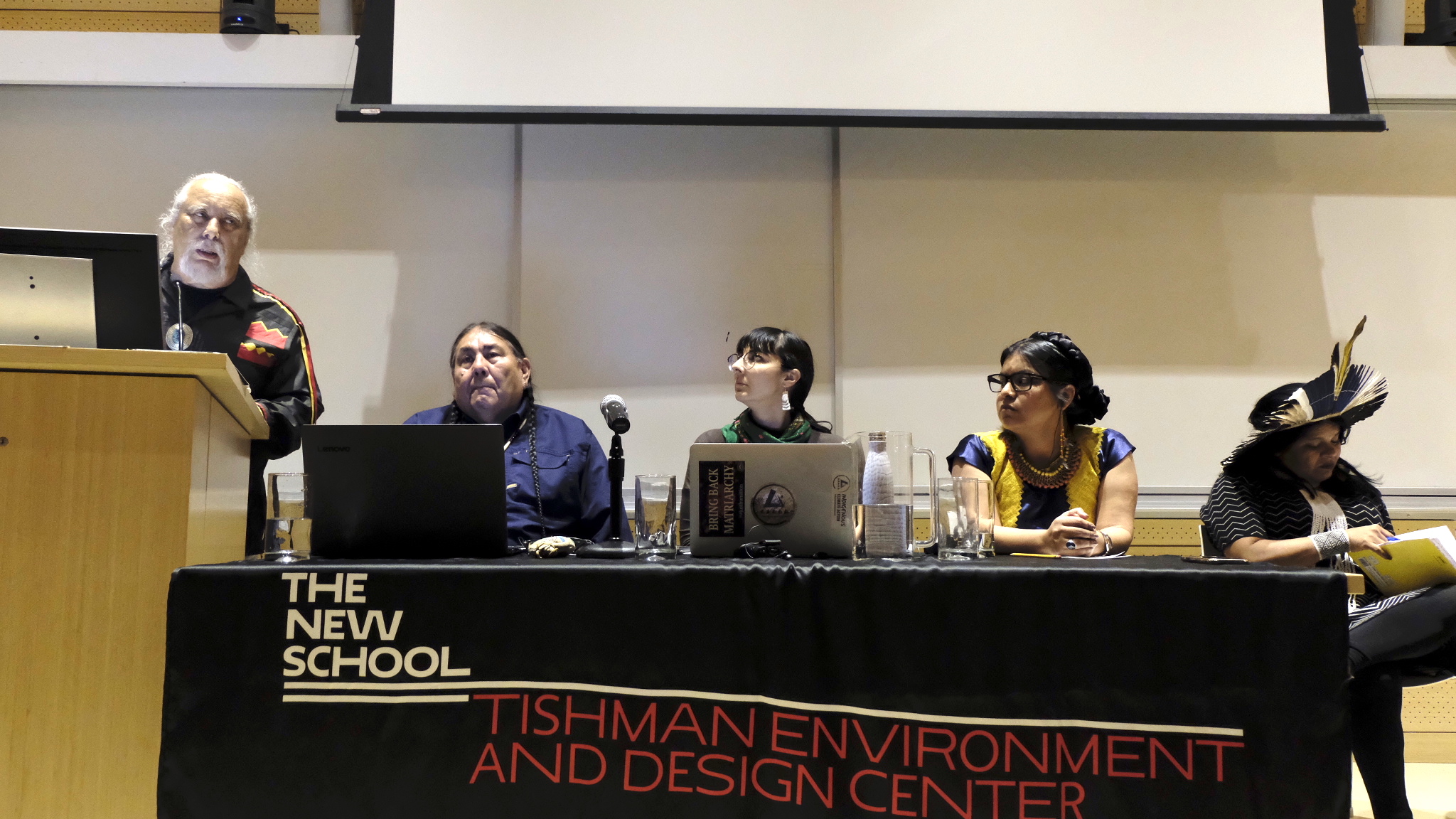In a time of calls for decolonization and recognition of the urgency of climate change, indigenous peoples are rising up and making their voices heard.
On the evening of Earth Day, April 22, The New School hosted “Indigenous Resistance and the Crisis of Mother Earth: Paths to Climate Justice,” a panel on indigenous knowledge focused on climate change and federal regulation, which included four indigenous activists and community leaders from the Americas.
The panel included Tom B.K. Goldtooth, of the Navajo Nation and Executive Director of the Indigenous Environmental Network, Sônia Guajajara of the Guajajara Indigenous Peoples in Brazil and the General Coordinator of The Articulation of Indigenous Peoples of Brazil, Eriel Tchekwie Deranger of the Athabasca Chipewyan First Nation of Canada and Executive Director of Indigenous Climate Action, and Dali Ángel Pérez of the Mexico Indigenous Zapotec tribe and co-chair of the Global Indigenous Youth Caucus and coordinator of the Network of Indigenous Youth from Mexico and Central America. The panel was moderated by Milano professor Leonardo Figueroa Helland. The conversation centered around the panel members’ communities’ issues and strategies to protect their land and their knowledge with regard to counteracting the impact of climate change.
The conversation opened with an introduction by Helland, who gave thanks to Mother Earth and Father Sun, followed by Chief Dwayne Perry of the Lenape Indian Nation giving welcome to his territory of New York.
Goldtooth spoke first, reflecting on Standing Rock and Dakota Access Pipelines’ lack of transparency. “These federal agents never asked permission [from the community elders],” Goldtooth said, in reference to oil drilling under the pipelines, which the elders predicted would eventually implode from the pressure.
Goldtooth described how he told others of the Indigenous Environmental Network’s ongoing fight with over 600 nations fighting lack of federal health standards.
“There are thousands of Standing Rocks,” Goldtooth said.
Deranger spoke next of the significance of growing up “existing with Mother Earth” despite the effects of modern colonization.
“I am the first generation to not speak my language as the first language. I am the first in my generation to not live on the land,” Deranger said.
Deranger spoke of her community’s relations next to the Alberta Tar Sands, large deposits of crude oil in Northern Alberta, Canada. She spoke of her community’s negotiations with self-described “ecosystem experts,” who asked her community elders for a yes or no answer regarding the Surface Water Quantity framework to measure healthy flow rates for the water.
“Our elders said, we need to understand what [meters per second flow rate] means. So they went out to the waterways, and they measured what that flow rate would be in the river systems. They measured the depth not to traverse through that area, but what would be needed to hunt a full bull moose, put it into the boat, and travel down the river. Ecological flow rate [base flow rate] more than doubled when the aboriginal values were added into the system. We were there managing the lands, it increases, our traditional knowledge changes the values and metrics of science tremendously. There are hundreds more–our values and [lifestyle] are not taken into consideration for developing the systems and pathways to ensure the stability of our ecosystems, lifestyles and climates here on Planet Earth.”
Pérez spoke next on how climate organizations in the Americas have the power to help restore clean energy while working with and respecting indigenous communities, emphasizing the UN’s
2030 agenda. “I have felt the most stress and tension in my region of Oaxaca,” said Pérez.
“In both the regions in the East, on the Pacific and Atlantic on the Gulf, the winds are so strong in it can jolt a truck to go left and right. It’s an area called the Vicious, but the people there are used to that. Part of what they’ve done because of those natural strong winds, they’ve established some parks. These parks generate energy from the wind,” said Pérez.
Guajajara followed, addressing the recent uprising of indigenous communities in Rio de Janeiro, Brazil against the current conservative president Jair Bolsonaro.
“The new president considered the indigenous people like animals, they’re not being considered as human beings, as if they need to be put in zoos until they are integrated into society,” said Guajajara. “What this government represents and offers is the army, the fight, the brand, the consumption and for the indigenous people, what really matters is the well being of the people of Brazil.” In 2015, Bolsonaro was quoted in an article by Campo Grande, a Brazilian news publication, that he did not understand how indigenous people owned their territories. “The Indians do not speak our language, they do not have money, they do not have culture. They are native peoples. How did they manage to get 13% of the national territory,” Bolsonaro said.
Guajajara was in tears. “That today, what is valuable for the country and the government is the stock market, is the G.D.P, the brand. What about their [indigenous peoples] lives? The indigenous lives? What’s going to happen when they’re being threatened on a daily basis?”
“We [indigenous activists] are talking about creating systemic alternatives–what do we need to do to shift climate change, right? But we look at systems of governance under the colonial system as the scope and spectrum in which we need to be searching for solutions,” said Deranger speaking to Free Press. “We need to widen and broaden our perspective of understanding and then we’ll actually start to see change.”







